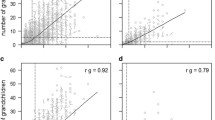Summary
Characteristics of a populations's reproductive system affect the degree of relatedness within the age cohorts and maternal sibships of that population. Two consequences of a small litter size, particularly of size one, a relatively polygynous mating system at any one time period, and frequent replacement of reproductively active males over successive periods, are that (1) the set of offspring that each female produces (a maternal sibship) will usually consist of halfsiblings, and (2) within a social group the members of each age cohort will be closely related, either all forming one paternal sibship (half-siblings) if there is only one reproductively active male at a time, or in the case of several reproductively active males, a set of individuals whose mean relatedness is some-what ower than in the one-father case. In the present paper, degree of relatedness within each of these two subgroups is calculated on the basis of a simple model. I then examine effects of the various reproductive parameters on this relatedness and compare maternal sibships and age cohorts in the relative degree of relatedness within them. Age cohorts will often be identifiable, closely related units, paternal sibships in the extreme case. Age cohorts may be important in the evolution of family altruism. They differ from maternal sibships in interesting ways that may affect the kinds of behaviors that are likely to evolve.
Similar content being viewed by others
References
Bertram, B.C.R.: Kin selection in lions and evolution. In: Growing points in ethology. Bateson, P.P.G., Hinde, R.A. (eds.), pp. 281–302, Cambridge. Cambridge University 1976
Brown, J.L.: Avian communal breeding systems. Annu. Rev. Ecol. Syst. 9, 123–155 (1978)
Charlesworth, B.: Some models of the evolution of altruistic behavior between siblings. J. Theor. Biol. 72, 297–319 (1978)
Hausfater, G.: Dominance and reproduction in baboons (Papio cynocephalus): A quantitative analysis. Basel: Karger 1975
Hrdy, S.B.: Male-male competition and infanticide among the langurs (Presbytis entellus) of Abu, Rajasthan. Folia Primatol. 22, 19–58 (1974)
Li, C.C.: Population genetics. Chicago: University of Chicago 1955
Moehlman, P.D.: Jackal helpers and pup survival. Nature 277, 382–383 (1979)
Nozawa, K.: Population genetics of Japanese monkeys. 1. Estimation of the effective group size. Primates 13, 381–393 (1972)
Packer, C.: Inter-troop transfer and inbreeding avoidance in Papio anubis. Anim. Behav. 27, 1–36 (1979)
Wade, M.J.: The evolution of social interactions by family selection. Am. Nat. 113, 399–417 (1979)
Woolfenden, G.E.: Florida scrub jay helpers at the nest. Auk 92, 1–15 (1975)
Author information
Authors and Affiliations
Rights and permissions
About this article
Cite this article
Altmann, J. Age cohorts as paternal sibships. Behav Ecol Sociobiol 6, 161–164 (1979). https://doi.org/10.1007/BF00292563
Received:
Accepted:
Issue Date:
DOI: https://doi.org/10.1007/BF00292563




